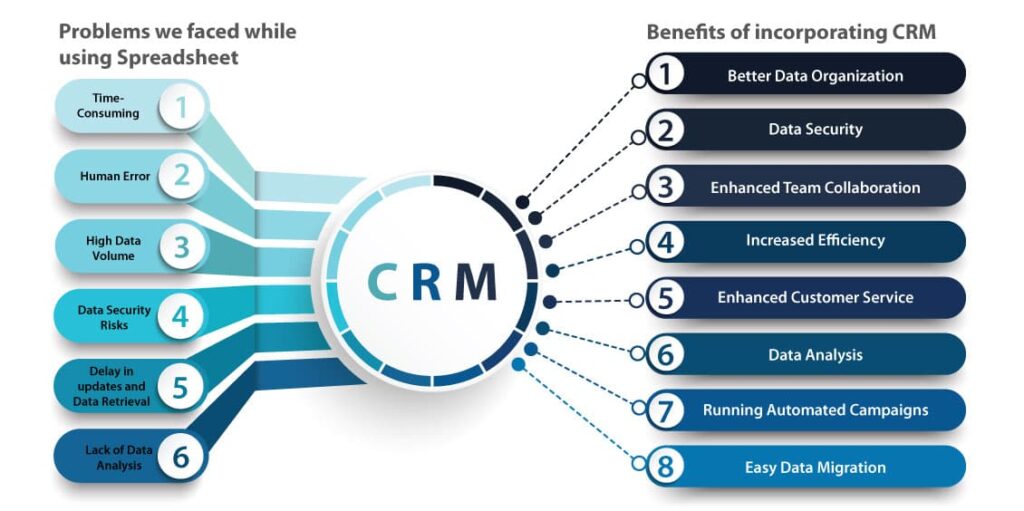Picture a business with a large consumer base and a sales team working dedicatedly. However, a major chunk of their time is spent in updating its customer records on spreadsheets. The team is struggling to maintain some kind of semblance of order in its records.
Sounds stressful, right?
Well, this was us before we put Customer Relationship Management (CRM) systems in place.
How we started
Just like any new business we were looking to make our mark in the business world, and this required creating a customer base. Lead generation was the priority and like most other startups we were relying on spreadsheets for managing the data of our leads. Managing diverse leads from different channels was a hands-on job for the sales team as they were manually updating the lead data.
This system worked fine for a while, we started noticing cracks in this manual method as the leads started building up and the volume of customer data expanded.
Problems we faced
Though maintaining customer data manually seemed like the obvious choice for us we soon realized that it comes with various challenges, such as:
1. Time consuming:
In the competitive world of business every second is precious and manually entering the data into spreadsheets was taking up a substantial chunk of our sales team’s time as it requires significant effort to input, update, and organize data especially when dealing with an ever-increasing customer database.
2. Human error:
With a large customer database, we were faced with the very real issue of human errors like typos, duplicate entries and incomplete or incorrect information. These errors lead to inaccuracy in our records which in turn impacted our decision-making.
3. High data volume:
Maintaining data on spreadsheets though the perfect choice at the start of our business became less practical with an increase in the number of leads. The increased data volume made it harder to keep track of all the leads and also led to us missing out on potential clients.
4. Data security risk:
Storing our customer data on spreadsheets made it more susceptible to unintentional damage and unauthorized access which could potentially compromise valuable customer information and negatively impact our sales.
5. Delay in updates and data retrieval:
We were unable to ensure timely updates in the data which made it challenging to access accurate and updated information as and when needed. To add to our problems, duplication of records and ineffective data updates made prompt data retrieval difficult leading to delays in customer service and decision-making processes.
6. Lack of data analysis:
Since we were unable to ensure data accuracy, in-depth data analysis became difficult which in turn limited our ability to derive meaningful insights from customer data.
How we overcame these issues
When faced with the above-mentioned challenges we started looking for better methods of lead data management and it was at this time that we discovered Customer Relationship Management (CRM) software. The CRM system made our data management streamlined by automating our data management process significantly improving our customer data management and resulting in better business performance.
What is a CRM?
A Customer Relationship Management (CRM) system is a business tech tool which combines software with business processes to assist organizations in collecting, organizing and analysing customer data. It centralizes customer data allowing businesses to obtain valuable insights into customer behaviour, preferences and needs thereby creating a stronger and more meaningful relationship between the business and its customers.
Who can benefit from it?
Any business from a solo freelancer to a multinational corporate giant can benefit from using CRM technology to effectively organize their data, centralize task management and automate marketing.

Advantages of incorporating CRM
Having incorporated CRM systems in our organization we realized the multiple benefits this small change made to our business.
In our experience some of the key advantages of adopting CRM are:
1. Better data organization:
Incorporation of CRM systems has been a game changer for us as organizing and centralizing our customer data has been made easier. Accuracy of data has been ensured and data duplication has been reduced making accessibility effortless.
2. Data security:
Using CRM systems has helped us up our data security game. Features like data encryption and access controls that restrict access to sensitive customer data, ensure that only authorized personnel can view, edit, or delete information thus protecting valuable customer information.
3. Enhanced team collaboration:
CRM systems allowed the different departments of our business, like sales and marketing, to improve communication and collaboration by enabling them to access and share customer information seamlessly. Not only did this make delegation of tasks easier but also helped make our teamwork stronger.
4. Increased efficiency:
By automating repetitive tasks and managing leads CRM systems have greatly helped our sales team to focus on converting leads into paying customers by ensuring that they follow-up on potential leads, monitor their progress and adjust their strategy to suit customer needs.
5. Enhanced customer service:
CRM systems helped our sales team access customer profiles with the details of their purchase history and our previous interactions with them. This information enabled us to serve our customers more efficiently resulting in higher customer satisfaction rates and increased customer loyalty.
6. Data analysis:
Implementation of CRM systems has provided us valuable insights about our business by providing us with real-time data which has enabled us to track our performance, identify market trends and make well-informed decisions to optimize our strategies.
7. Running automated campaigns:
Using a CRM system enabled us to run a successful automated email campaign which helped deliver the right message at the right time to the right audience, increasing the effectiveness of our marketing initiatives. The quick integration of the CRM system with different advertising and marketing platforms made running campaigns easy and efficient.
8. Easy data migration:
CRM tools for data migration simplified the process of data migration and helped ensure that our data was transferred accurately and with minimum errors. This not only made our transition to CRM smooth but also protected our valuable customer data throughout the process.
Takeaway
In today’s fast-paced and customer-centric business world, a CRM system empowers businesses to effectively manage customer relationships, drive sales, optimize marketing efforts, deliver superior customer service and make informed decisions for sustainable growth and success.
In author Bobby Darnell’s words:
“CRM is your GPS to a better route on your Business Development journey.”
Have you implemented a CRM system in your business?
Share your experience with us in the comment section below.







